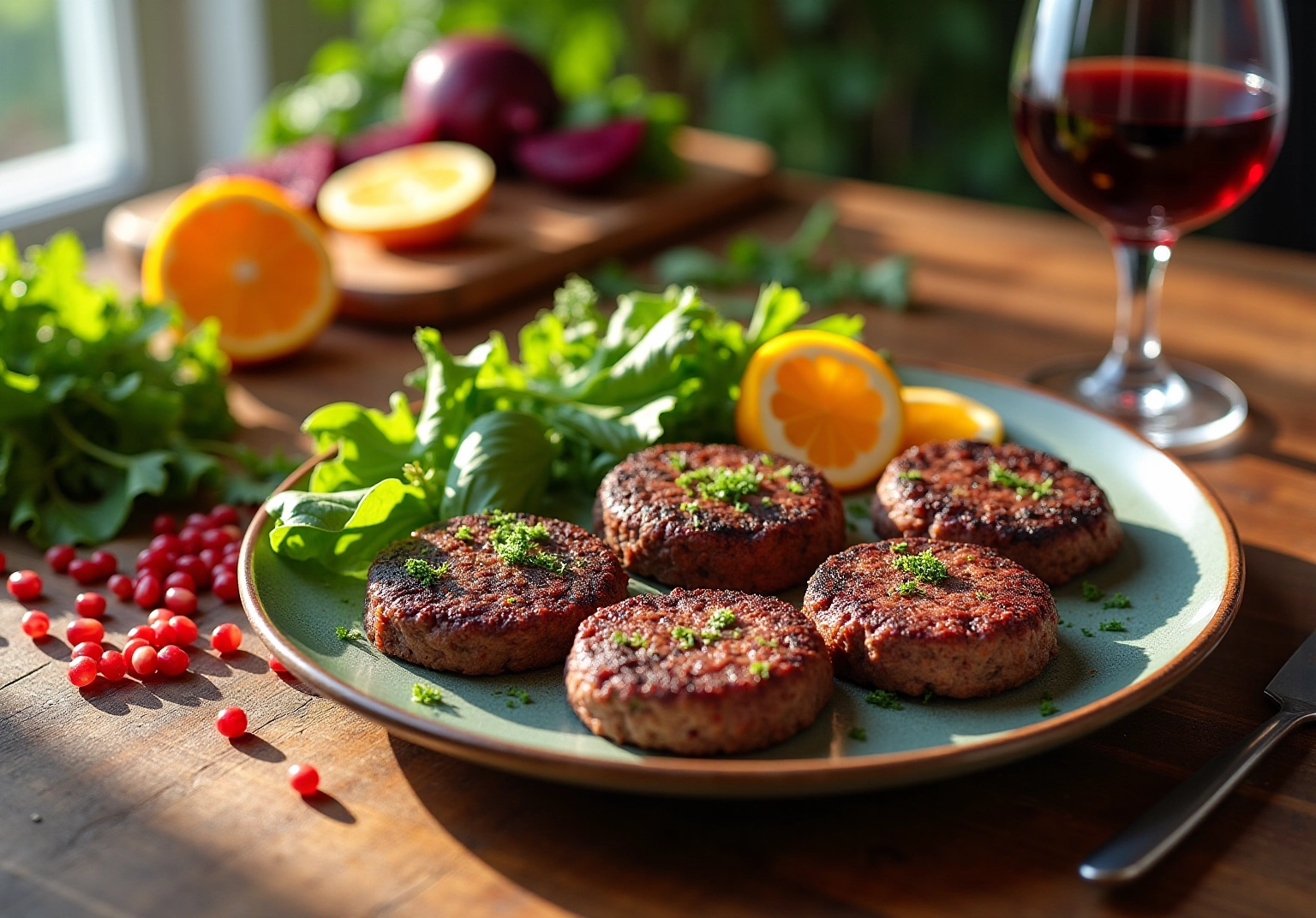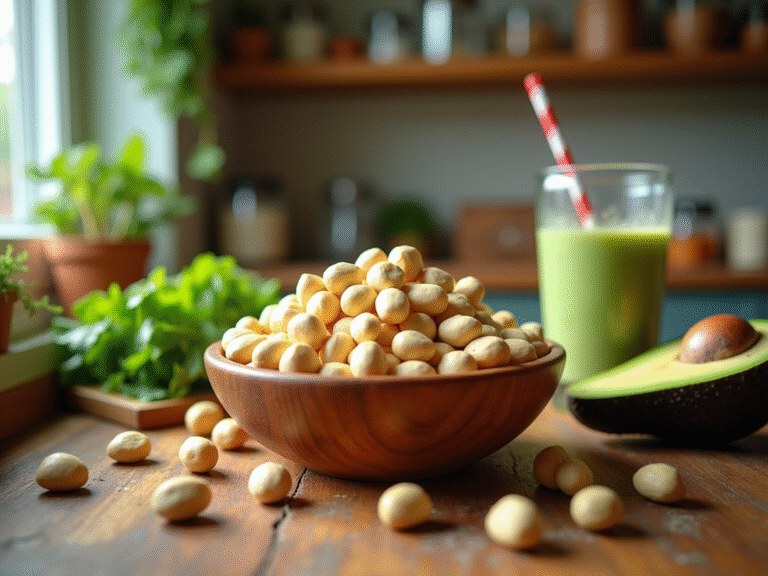10 Natural Nitric Oxide Foods to Boost Your Health
Overview
The article emphasizes ten natural foods that can elevate nitric oxide levels, which play a crucial role in cardiovascular health. Notable examples include:
- Beets
- Garlic
- Dark chocolate
Research supports their positive impacts on circulation and blood pressure, illustrating the significance of integrating these nutrient-dense foods into a balanced diet. By doing so, individuals can enhance their overall well-being and promote heart health.
Introduction
The quest for optimal health often leads individuals to explore the benefits of dietary choices, particularly those that enhance cardiovascular function. Among these, nitric oxide-rich foods stand out, offering a natural way to support circulation and overall wellness.
This article delves into ten exceptional foods that can elevate nitric oxide levels, revealing not only their health benefits but also how they can be seamlessly integrated into daily diets.
What if the key to better heart health lies in the foods on your plate? Let’s discover how these dietary choices can make a significant difference.
ByKomi’s Savory Beef Liver Patties: A Nutrient-Dense Nitric Oxide Booster
ByKomi’s savory beef liver patties offer not only a culinary delight but also a powerhouse of essential nutrients, including vitamin B12, iron, folate, and phosphorus. These nutrients play a crucial role in the creation of nitrogen compounds, vital for promoting healthy circulation and optimal cardiovascular performance.
Research indicates that diets rich in beef liver, which is among the natural nitric oxide foods, can significantly boost nitric oxide levels, making it an excellent choice for individuals aiming to enhance their overall well-being naturally. Nutritionists emphasize that incorporating nutrient-dense foods like beef liver into daily meals can lead to improved cardiovascular function, aiding the body’s ability to regulate blood pressure and enhance circulation.
For instance, many fitness enthusiasts have successfully integrated beef liver into their diets, experiencing notable improvements in their vitality and health. As Lisa Hunter pointed out, ‘Beef liver is an extraordinary source of vitamin B12, providing an astounding 2471% of the daily value per 3.5-ounce serving!’
However, it is essential to consume beef liver in moderation due to the potential risk of vitamin A toxicity. By adding beef liver to your diet, you not only enjoy its rich flavor but also benefit from its impressive properties as one of the natural nitric oxide foods, particularly in enhancing nitrogen levels and promoting cardiovascular health.
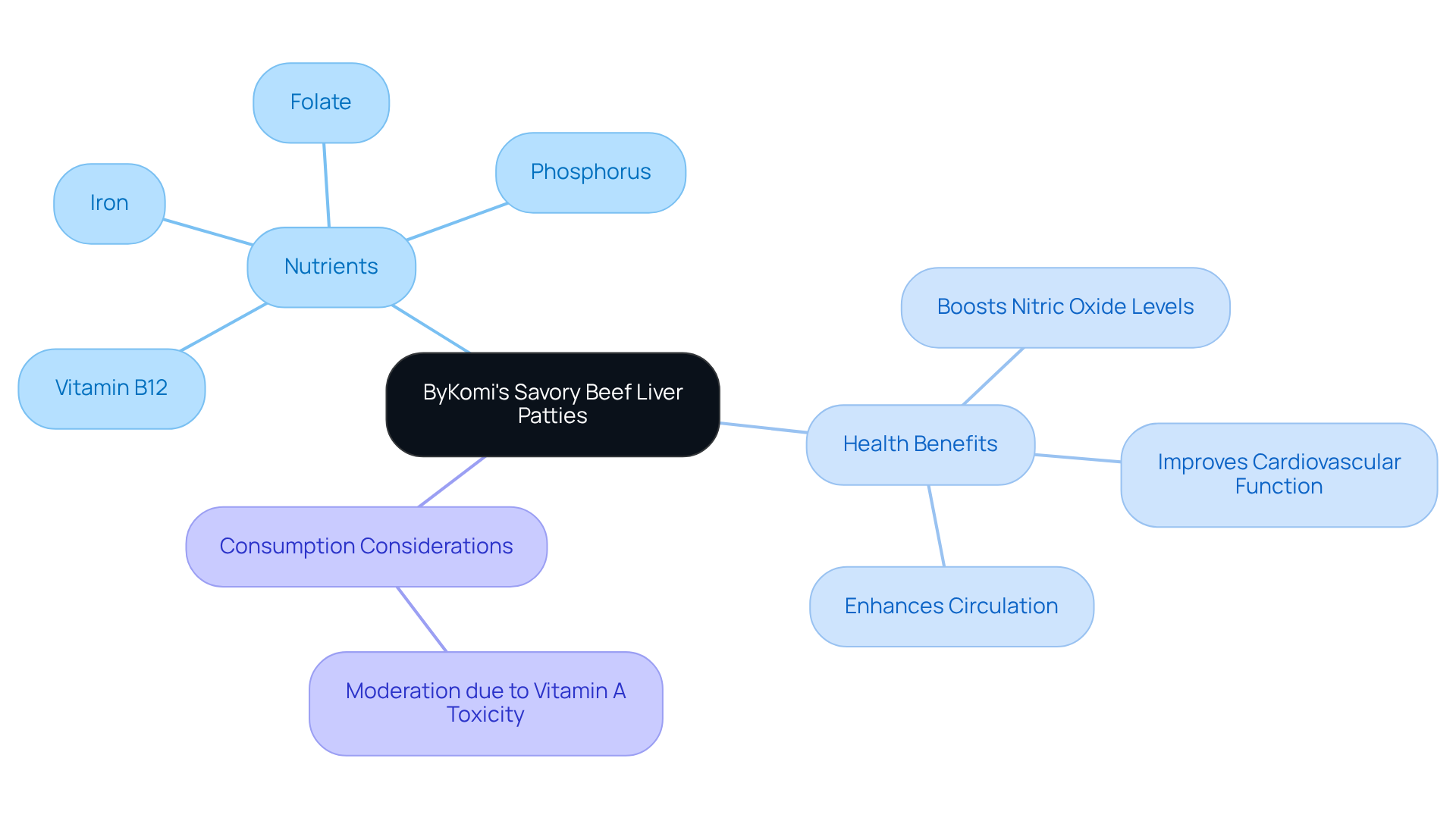
Beets: The Ultimate Natural Source of Nitric Oxide
Beets are among the most abundant sources of dietary nitrates, which the body transforms into nitric oxide—an essential compound for cardiovascular well-being. Frequent intake of beets has been linked to notable health advantages, such as reduced pressure in the vessels, enhanced exercise performance, and improved overall heart function. A systematic review highlighted that drinking beet juice can lead to an average reduction of 3.55 mm Hg in systolic pressure and 1.32 mm Hg in diastolic pressure, according to a 2017 meta-analysis. This makes it a powerful ally for those managing hypertension. To experience significant benefits for hypertension, drinking beet juice daily for at least 60 days is suggested.
Whether enjoyed raw, roasted, or as juice, beets are a versatile addition to any diet that incorporates natural nitric oxide foods to boost nitric oxide levels. Their elevated nitrate levels not only assist in relaxing and widening blood vessels but also promote enhanced circulation and cardiovascular health. Additionally, the antioxidant properties of beets contribute to their role as a functional food, promoting overall well-being.
However, it is important to note that excessive beet juice consumption may lead to symptoms of hypotension, such as dizziness, and could increase the risk of kidney stones for susceptible individuals. Including beets in your meals can be a tasty and impactful approach to improving cardiovascular wellness naturally, especially when combined with other natural nitric oxide foods, although they might not be as potent as medications for high blood pressure.
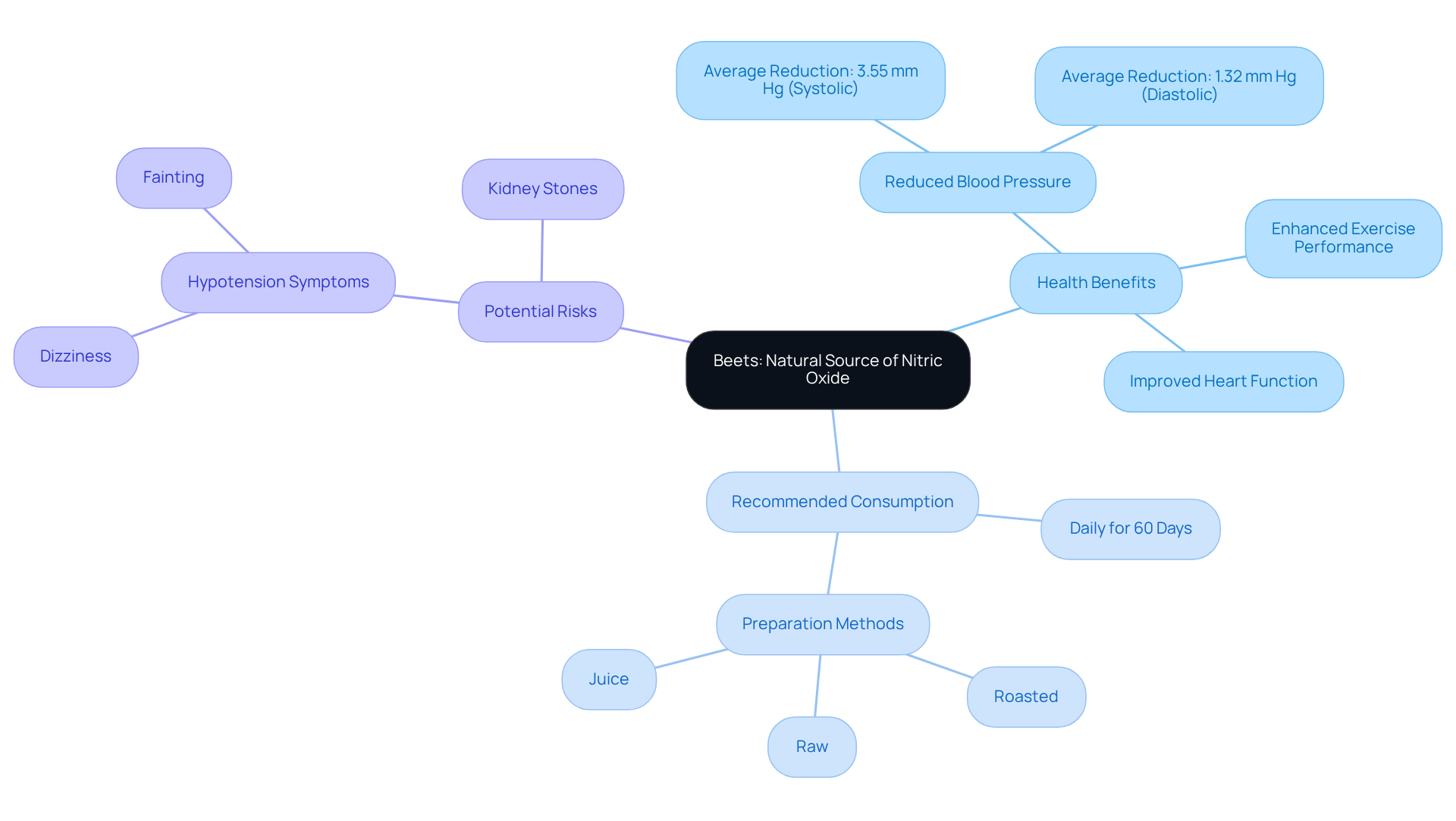
Garlic: A Flavorful Food That Boosts Nitric Oxide Levels
Garlic is not just a flavorful addition to your meals; it serves as a powerful ally for your health. Garlic, which is rich in allicin, a sulfur-containing compound, is linked to significant cardiovascular benefits, particularly due to its role as one of the natural nitric oxide foods that enhance nitric oxide production. The increase in natural nitric oxide foods, such as garlic, can improve circulation and lower arterial pressure, making it a valuable dietary component for heart health.
Recent studies indicate that garlic supplementation can effectively reduce both systolic and diastolic blood pressure. A meta-analysis revealed an average decrease of 8.3 mmHg in systolic blood pressure and 5.5 mmHg in diastolic blood pressure among individuals with hypertension. These reductions are comparable to those achieved with conventional antihypertensive medications, as demonstrated in a study involving 553 participants.
By incorporating garlic, which is among the natural nitric oxide foods, into your daily diet—whether through raw cloves, garlic powder, or infused oils—you can enjoy its robust flavor while reaping its health benefits. This simple dietary adjustment can significantly support your cardiovascular health and enhance your overall well-being. Why not start adding garlic to your meals today?
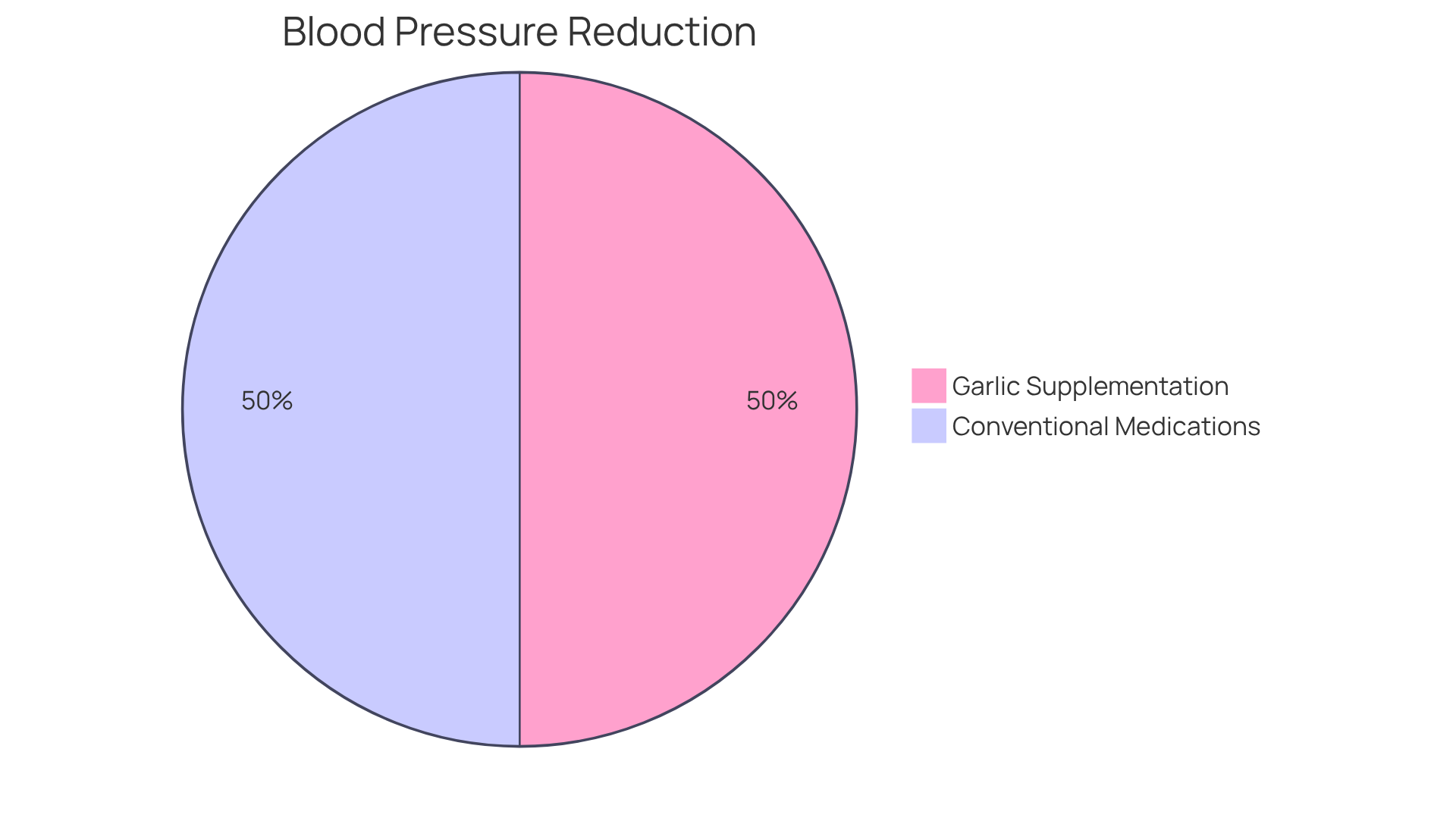
Dark Chocolate: A Tasty Treat for Nitric Oxide Enhancement
Dark chocolate, particularly varieties with higher cocoa content, is considered one of the natural nitric oxide foods due to its rich flavanol content, which promotes the production of nitrogen compounds. Research indicates that regular consumption of dark chocolate can significantly enhance endothelial function and improve circulation, making it a delightful ally for cardiovascular health. For example, a study revealed that participants who consumed 30 grams of dark chocolate daily for 15 days experienced a notable increase in nitric oxide serum levels, which are among the benefits of natural nitric oxide foods, along with reductions in systolic blood pressure.
Furthermore, the flavanols in dark chocolate have been linked to improved vascular health, with findings suggesting they can reduce arterial stiffness and enhance overall cardiovascular function. Additionally, dark chocolate may positively influence gut microbiome diversity, contributing to overall well-being. However, it’s crucial to recognize that flavanol content can vary significantly among different dark chocolate products, making the selection of high-quality options essential.
Incorporating a small piece of dark chocolate into your daily routine not only satisfies your sweet tooth but also supports cardiovascular wellness. Remember, moderation is key; since dark chocolate is calorie-dense, balancing its consumption with a healthy diet is vital.

Leafy Greens: Essential Vegetables for Nitric Oxide Support
Leafy greens, such as spinach, kale, and arugula, are considered natural nitric oxide foods due to their richness in nitrates, which the body converts into nitric oxide—a vital compound for cardiovascular health. Consistent intake of these vegetables can assist in managing blood pressure and improving overall heart performance. Research indicates that diets rich in natural nitric oxide foods, particularly leafy greens, are associated with a lower risk of cardiovascular diseases due to their high nitrate content. For instance, studies have shown that individuals who consume nitrate-rich vegetables daily experience significant improvements in blood pressure levels, with a reduction of approximately 2.5 mmHg in systolic blood pressure.
To maximize health benefits, it is advisable to incorporate a diverse range of greens and natural nitric oxide foods into your meals, as each type provides unique nutrients that support heart health and overall vitality. Furthermore, steering clear of inhibitors, like processed foods, can further boost levels of nitrogen. As dietitian Rachael Ajmera observes, ‘To boost nitrogen levels, you can consume foods like beets, garlic, meat, leafy greens, and citrus.’ Embracing these nutrient-dense foods is a proactive step toward maintaining a healthy cardiovascular system. Recognizing the cultural significance of leafy greens in various cuisines can also enrich your dietary choices.
How can you include more leafy greens in your daily meals?
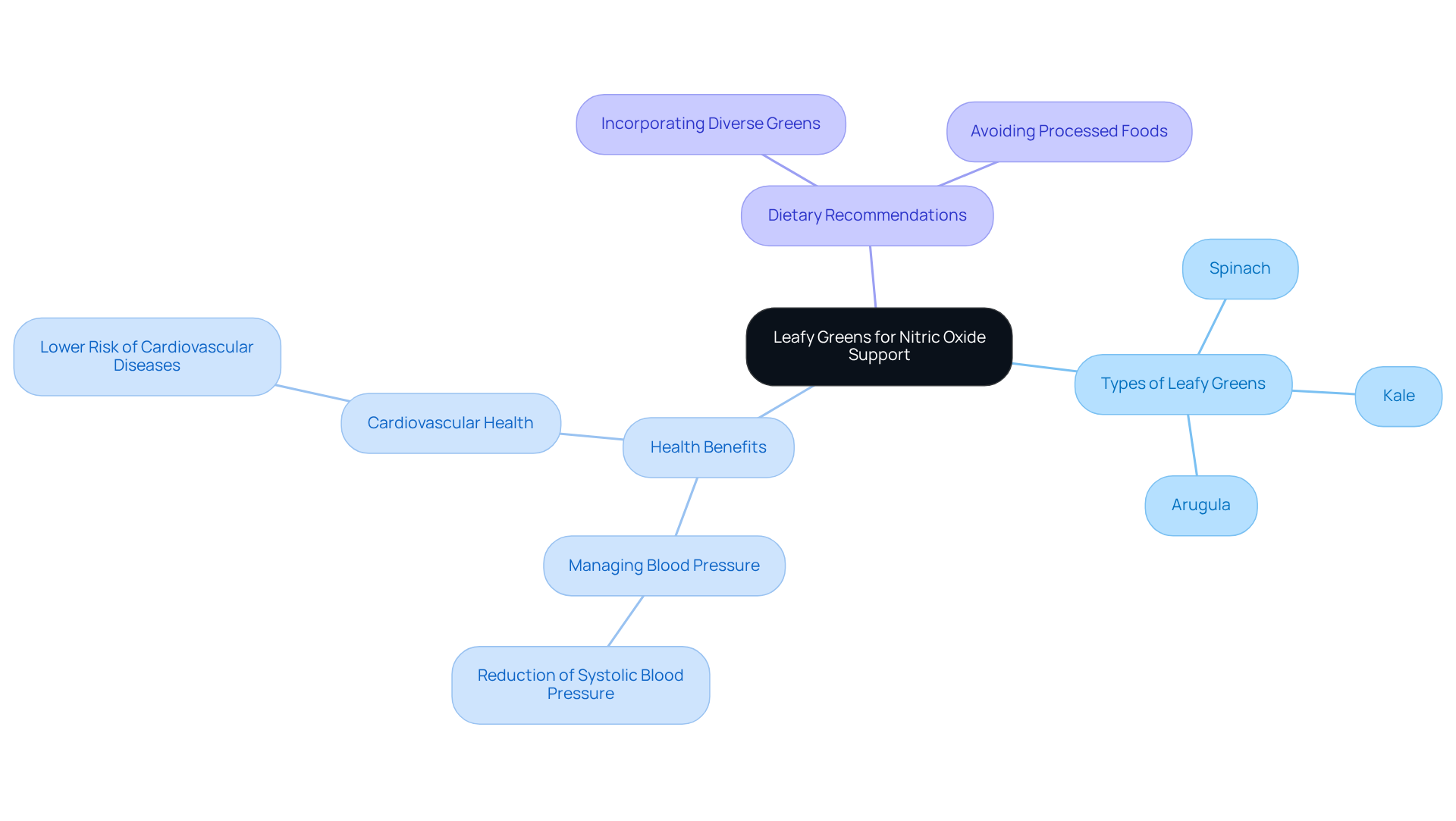
Citrus Fruits: Refreshing Sources of Nitric Oxide Support
Citrus fruits, including oranges, lemons, and grapefruits, are not only refreshing but also considered natural nitric oxide foods due to their richness in vitamin C, which plays a crucial role in stabilizing and boosting nitrogen monoxide levels in the body.
Research indicates that vitamin C helps protect nitrogen monoxide from degradation, thereby extending its beneficial effects on cardiovascular health when included in natural nitric oxide foods.
For instance, studies have shown that regular consumption of natural nitric oxide foods, such as citrus fruits, can enhance blood circulation and lower blood pressure, contributing to overall heart health.
Nutritionists stress the importance of including natural nitric oxide foods in your diet, as they provide essential nutrients and support cardiovascular function.
Rachael Ajmera, MS, RD, notes, “Citrus fruits are rich in vitamin C, which aids in protecting and maintaining levels of natural nitric oxide foods in the body.”
Incorporating citrus fruits into your meals—like adding lemon juice to salads or enjoying orange slices as snacks—can significantly boost your well-being and energy.
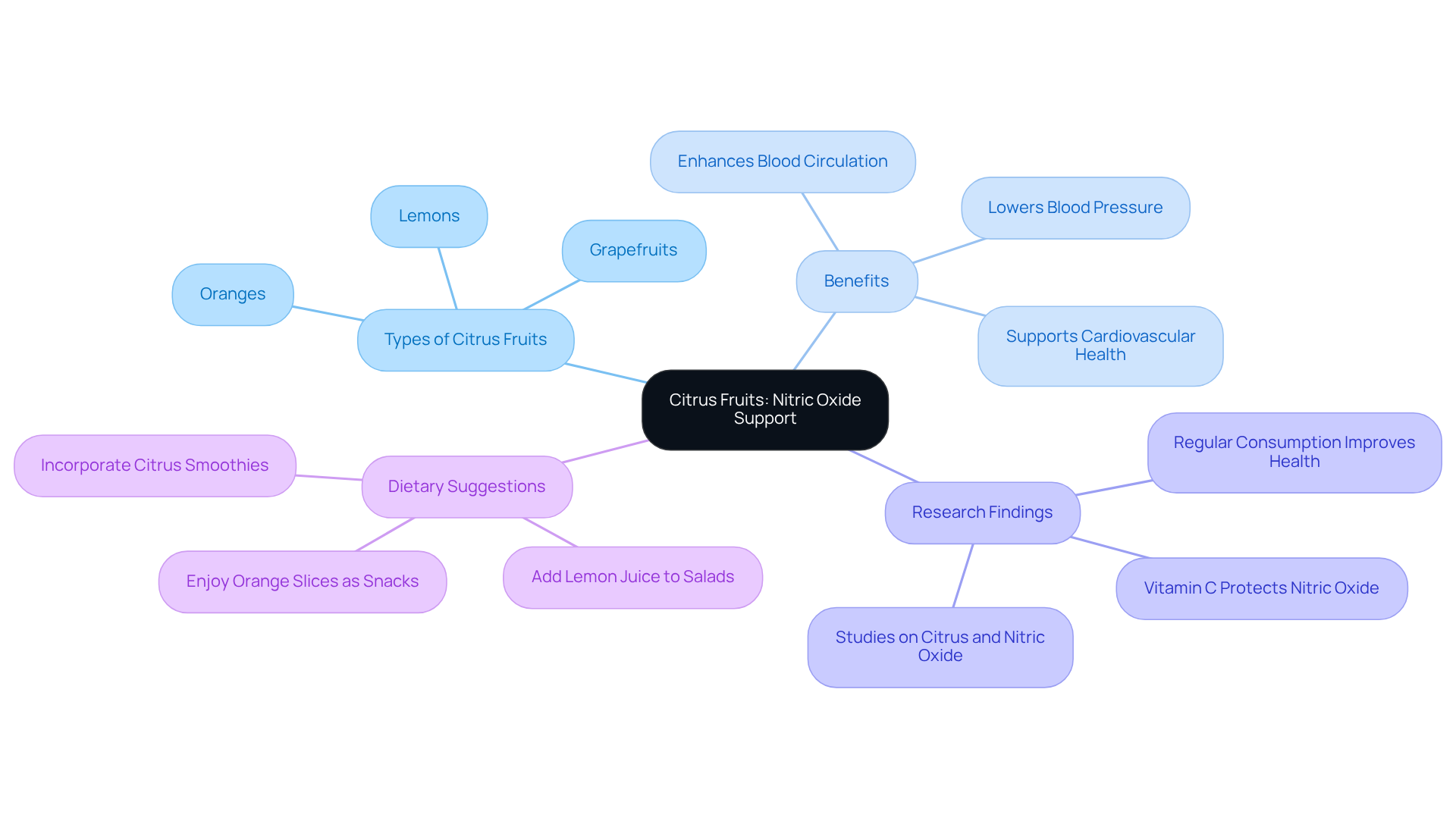
Pomegranates: Antioxidant-Rich Fruits for Nitric Oxide Boost
Pomegranates are a rich source of antioxidants, particularly polyphenols, which play a crucial role in protecting nitrogen compounds from oxidative damage. Studies indicate that consuming pomegranate juice or seeds, recognized as natural nitric oxide foods, can significantly enhance nitric oxide activity in the body, thereby supporting cardiovascular function and improving circulation.
For example, research has demonstrated that pomegranate extract can increase vessel diameter from 0.39 ± 0.07 cm to 0.42 ± 0.07 cm (p = 0.036) and boost blood flow from 29.6 ± 24.9 ml/min to 40.6 ± 24.8 ml/min (p = 0.033), both of which are vital for optimal heart function. Furthermore, the polyphenols in pomegranates contribute to better endothelial function, further promoting heart health. Participants reported significantly greater feelings of vitality after consuming pomegranate extract compared to a placebo (p = 0.037).
Including pomegranates in your diet not only enhances flavor but also offers substantial benefits for heart health, making them one of the top natural nitric oxide foods for those looking to naturally elevate their levels of this beneficial compound.
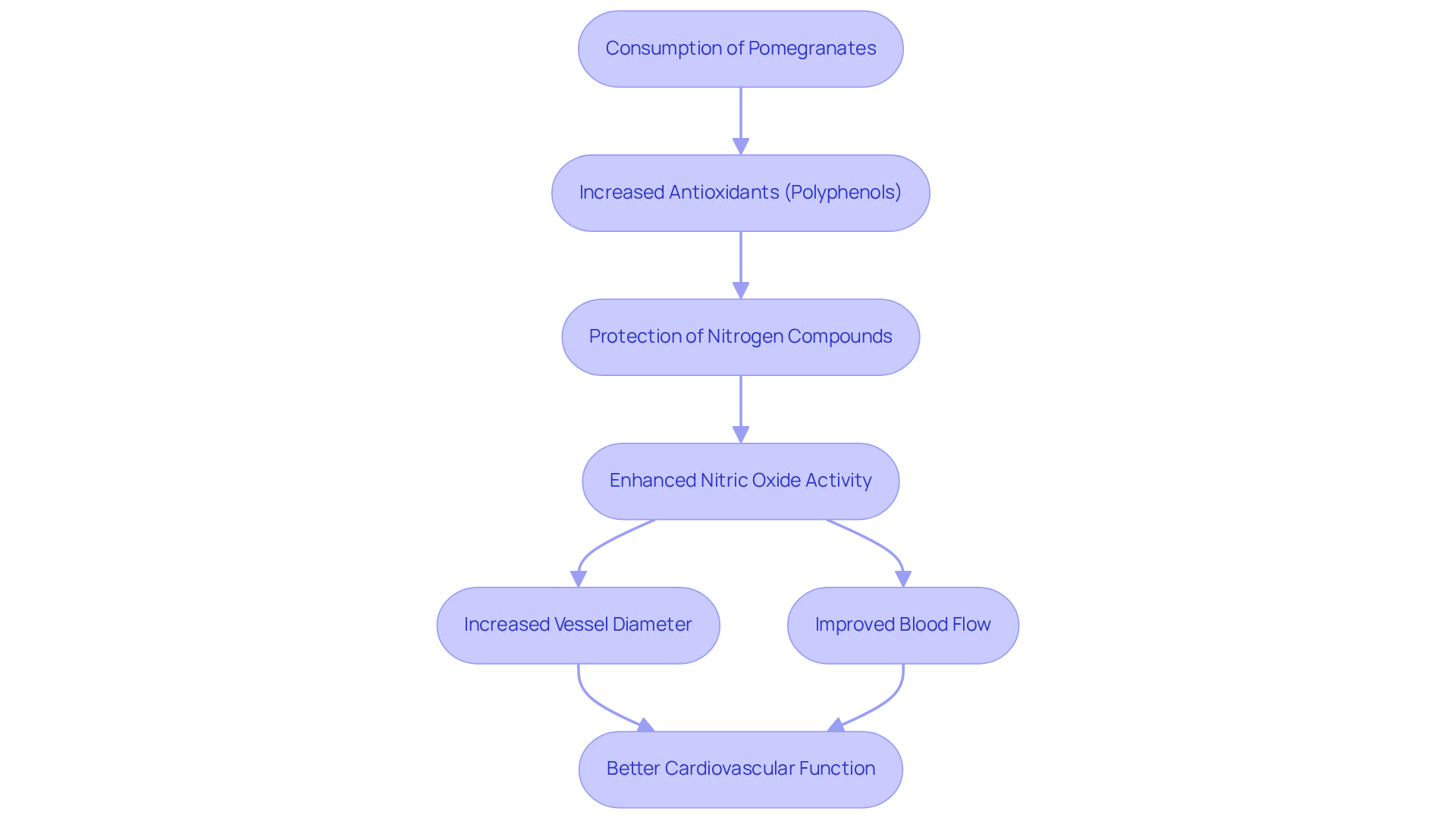
Nuts and Seeds: Nutrient-Dense Snacks for Nitric Oxide Levels
Nuts and seeds, such as walnuts, almonds, and flaxseeds, are considered natural nitric oxide foods due to their richness in L-arginine, an amino acid essential for the synthesis of nitrogen monoxide. Incorporating natural nitric oxide foods and a few nutrient-dense snacks into your diet can significantly elevate your nitrogen levels, thereby promoting heart health. Recent studies have underscored the cardiovascular advantages of L-arginine, particularly from natural nitric oxide foods such as nuts. For instance, research indicates that incorporating natural nitric oxide foods, such as arginine-rich nuts, into your diet can boost nitrogen levels in the bloodstream within just two weeks.
Nutrition experts, including Cara Rosenbloom, emphasize that natural nitric oxide foods rich in L-arginine not only aid in the production of nitrogen compounds but also play a vital role in maintaining vascular health and reducing oxidative stress. By incorporating natural nitric oxide foods like nuts and seeds into a balanced diet, you can leverage their nutritional benefits to enhance cardiovascular wellness and overall vitality.
So, why not aim to include a handful of nuts in your daily snacks? Doing so can help you reap these health benefits and support your journey towards better heart health.
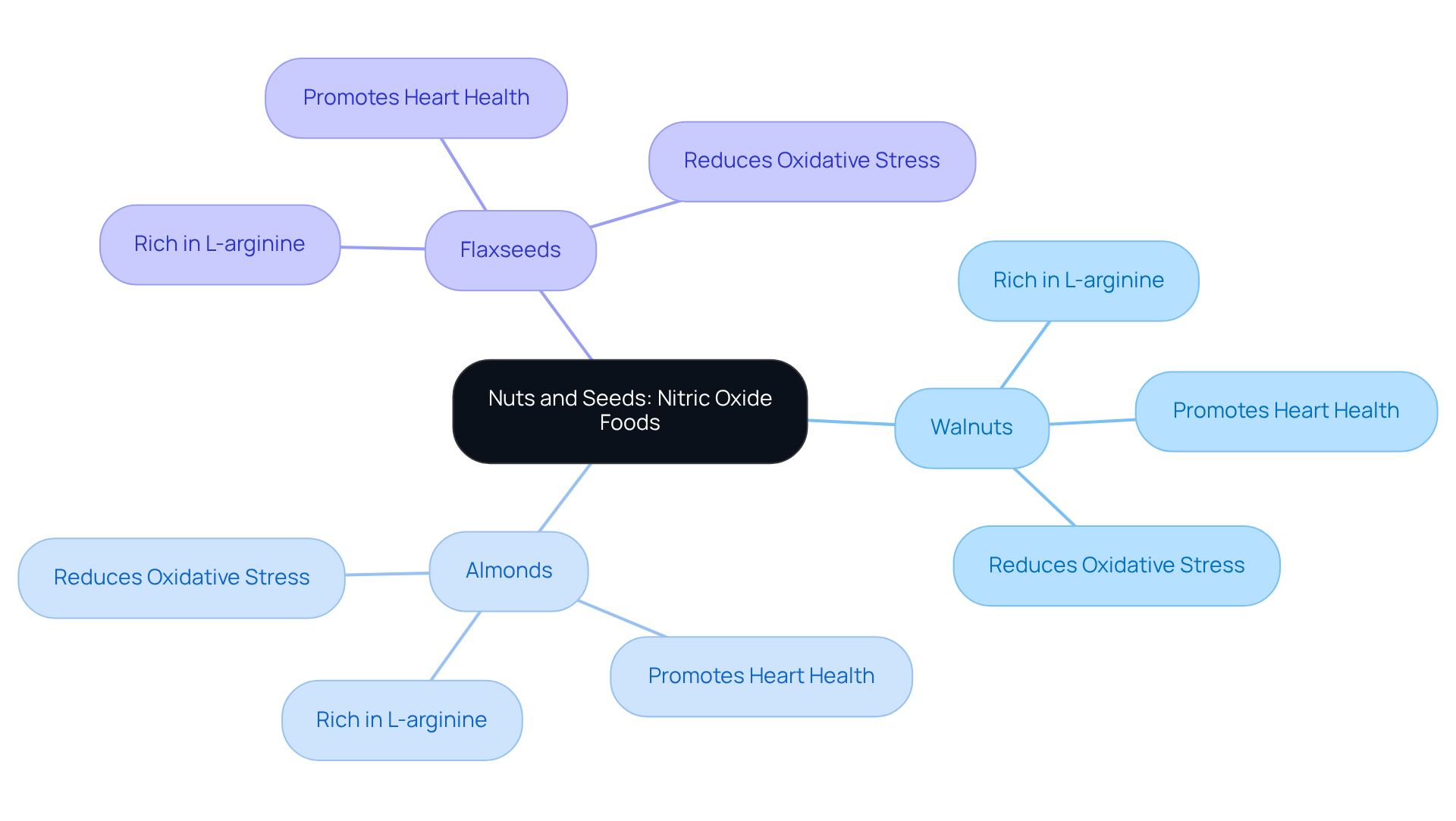
Watermelon: A Hydrating Fruit That Boosts Nitric Oxide
Watermelon is not just a refreshing summer fruit; it is also considered one of the natural nitric oxide foods, as it is an excellent source of citrulline, an amino acid that your body converts into arginine and subsequently into nitrogen gas. This transformation is crucial for various bodily functions. Furthermore, frequent consumption of watermelon, a type of natural nitric oxide food, can enhance blood circulation and reduce blood pressure. This provides a delicious way to promote your cardiovascular well-being. Consider incorporating watermelon into your diet to reap these health benefits.
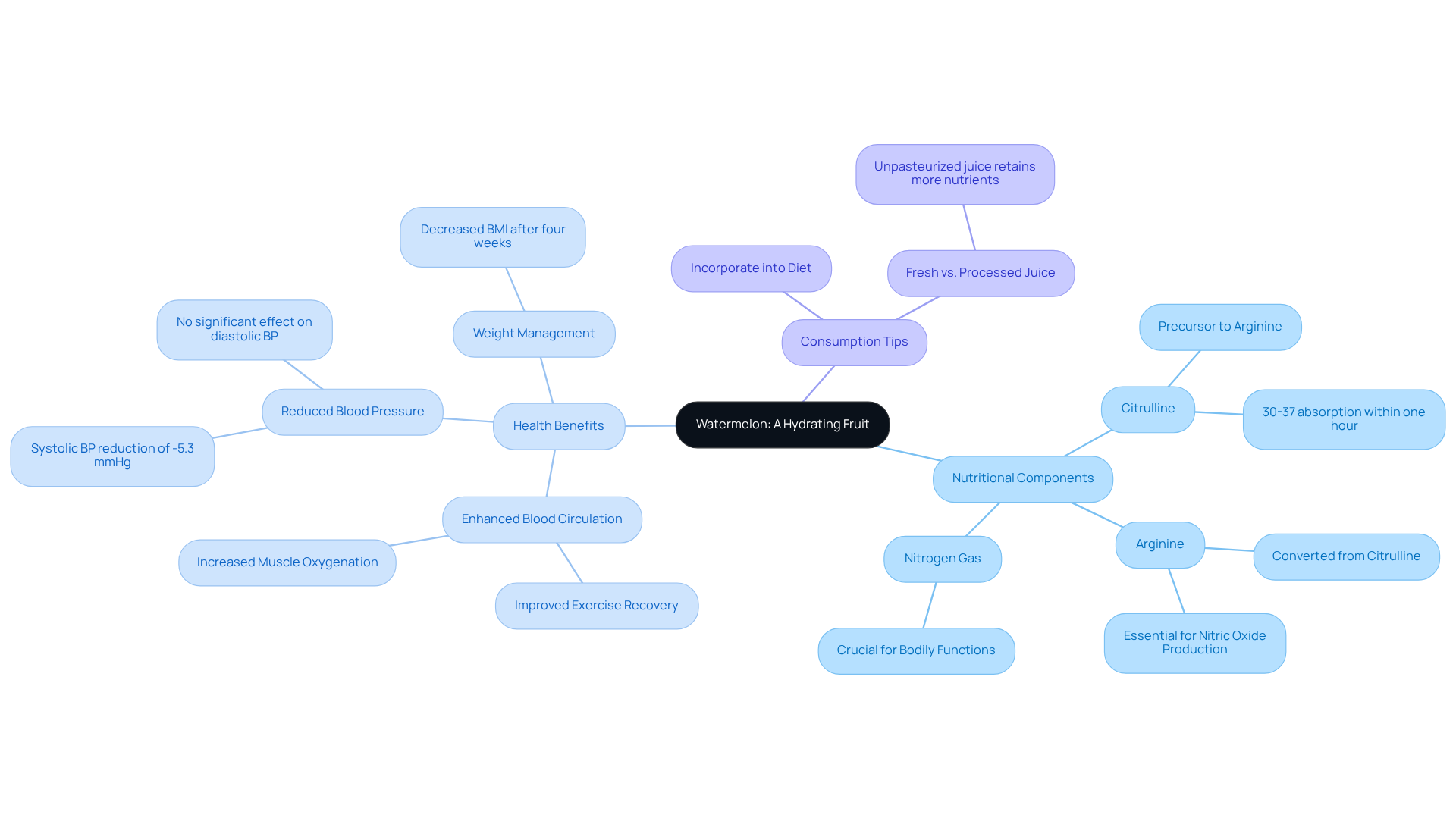
Red Wine: A Moderate Indulgence for Nitric Oxide Enhancement
Moderate intake of red wine is associated with various health advantages, particularly in boosting the production of natural nitric oxide foods. The polyphenols found in red wine, such as resveratrol, play a crucial role in promoting the expression of endothelial synthase (eNOS), which subsequently increases levels of gas in the body. Research indicates that red wine polyphenols can significantly enhance eNOS activity. Studies have demonstrated that RWPE treatment raised nitrogen monoxide release from human umbilical vein endothelial cells (HUVECs) by as much as threefold following treatment with red wine polyphenol extracts. The enhancement of nitric oxide, particularly through natural nitric oxide foods, is vital for cardiovascular well-being as it promotes vasodilation and improves blood flow.
Furthermore, the ‘French paradox’ illustrates the lower incidence of coronary heart disease in France, often attributed to regular red wine consumption alongside a high-fat diet. Nutritionists emphasize that enjoying a glass of red wine with dinner can be a heart-healthy choice when consumed in moderation—typically defined as one 5-ounce glass for women and one to two for men per day. This moderate intake is linked to decreased cardiovascular disease incidence and supports cardiovascular function while contributing to overall well-being, making red wine a beneficial addition to a balanced diet.
In addition, studies have shown that plasma polyphenols increased to 6.4±3.0 mg/g protein after consuming 375 mL of red wine per day for two weeks, further underscoring the health benefits of moderate red wine consumption.

Conclusion
Incorporating natural nitric oxide foods into your diet is a powerful strategy for enhancing cardiovascular health and overall well-being. This article highlights a variety of nutrient-dense options, including:
- Beef liver
- Beets
- Garlic
- Dark chocolate
- Leafy greens
- Citrus fruits
- Pomegranates
- Nuts and seeds
- Watermelon
- Red wine
Each of these foods plays a significant role in boosting nitric oxide levels, which are crucial for maintaining healthy circulation and heart function.
Key insights reveal how specific nutrients found in these foods contribute to improved blood flow, reduced blood pressure, and enhanced exercise performance. For instance, the nitrates in beets and leafy greens are converted into nitric oxide, while garlic’s allicin and the polyphenols in dark chocolate and red wine further support this vital process. By embracing these natural foods, individuals can make meaningful changes to their diets that promote cardiovascular health.
Ultimately, the message is clear: prioritizing natural nitric oxide foods is not just a dietary choice but a proactive step towards a healthier life. By incorporating these foods into daily meals, you can harness their numerous health benefits, from improved heart function to enhanced vitality. Embrace this opportunity to nourish your body and support cardiovascular wellness through delicious and nutritious options.
Frequently Asked Questions
What are ByKomi’s savory beef liver patties known for?
ByKomi’s savory beef liver patties are recognized for being nutrient-dense, containing essential nutrients like vitamin B12, iron, folate, and phosphorus, which are crucial for promoting healthy circulation and optimal cardiovascular performance.
How do beef liver patties impact nitric oxide levels?
Diets rich in beef liver can significantly boost nitric oxide levels, making it a beneficial choice for individuals looking to enhance their overall well-being naturally.
What are the cardiovascular benefits of incorporating beef liver into the diet?
Incorporating beef liver can lead to improved cardiovascular function, aiding the body’s ability to regulate blood pressure and enhance circulation.
What is the recommended serving size of beef liver for vitamin B12 intake?
A 3.5-ounce serving of beef liver provides an astounding 2471% of the daily value for vitamin B12.
Are there any risks associated with consuming beef liver?
Yes, it is essential to consume beef liver in moderation due to the potential risk of vitamin A toxicity.
What are the health benefits of beets?
Beets are rich in dietary nitrates, which the body converts into nitric oxide, leading to benefits such as reduced vascular pressure, enhanced exercise performance, and improved heart function.
How does beet juice consumption affect blood pressure?
Drinking beet juice can lead to an average reduction of 3.55 mm Hg in systolic pressure and 1.32 mm Hg in diastolic pressure, making it beneficial for managing hypertension.
What is the suggested duration for drinking beet juice to experience significant benefits for hypertension?
It is suggested to drink beet juice daily for at least 60 days to experience significant benefits for hypertension.
Are there any risks associated with excessive beet juice consumption?
Yes, excessive beet juice consumption may lead to symptoms of hypotension, such as dizziness, and could increase the risk of kidney stones for susceptible individuals.
What are the health benefits of garlic?
Garlic is linked to cardiovascular benefits due to its rich content of allicin, which enhances nitric oxide production, improving circulation and lowering arterial pressure.
How effective is garlic supplementation for blood pressure reduction?
Garlic supplementation can effectively reduce systolic and diastolic blood pressure, with a meta-analysis showing an average decrease of 8.3 mmHg in systolic and 5.5 mmHg in diastolic blood pressure among individuals with hypertension.
How can garlic be incorporated into the diet?
Garlic can be added to the diet in various forms, including raw cloves, garlic powder, or infused oils, to enjoy its flavor while benefiting from its health properties.
